HAT304 - Policy Proposal: Disaster Management in Hospitality Sector
VerifiedAdded on 2023/06/04
|9
|2200
|257
Report
AI Summary
This report presents a policy draft addressing disaster management in Queensland's hospitality and tourism sector, particularly in light of Cyclone Debbie's impact. It identifies legal and regulatory concerns, such as inadequate building regulations and disaster preparedness, and proposes policy objectives including better fund allocation, mandatory building checks, a hotel/shelter program, improved drainage systems, and enhanced disaster management training. The proposal emphasizes the need for long-term investment in preventative measures rather than solely focusing on post-disaster marketing. Key stakeholders involved in the implementation of these policies are also outlined. This assignment solution is available on Desklib, along with a wide range of study resources including past papers and solved assignments.
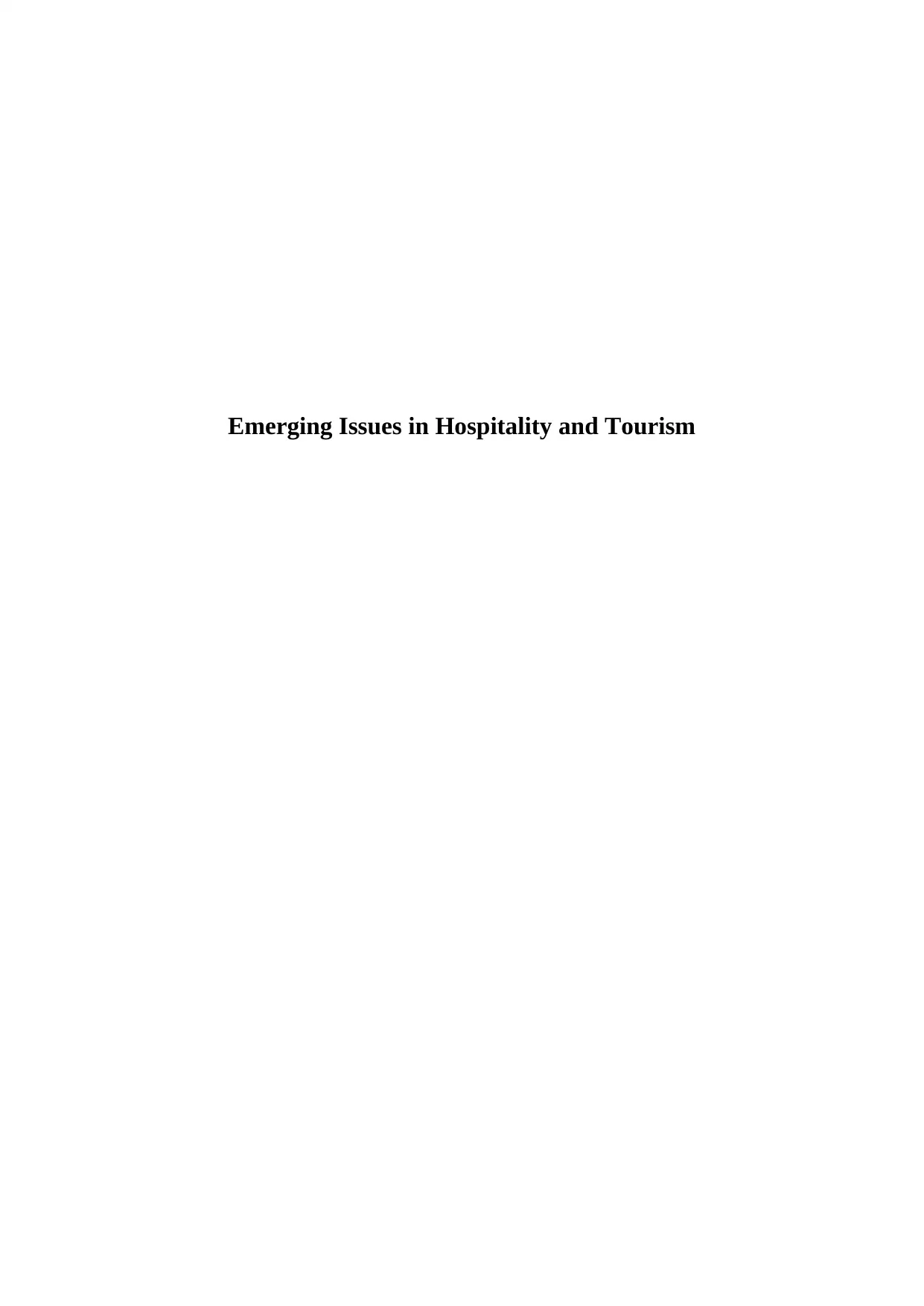
Emerging Issues in Hospitality and Tourism
Paraphrase This Document
Need a fresh take? Get an instant paraphrase of this document with our AI Paraphraser
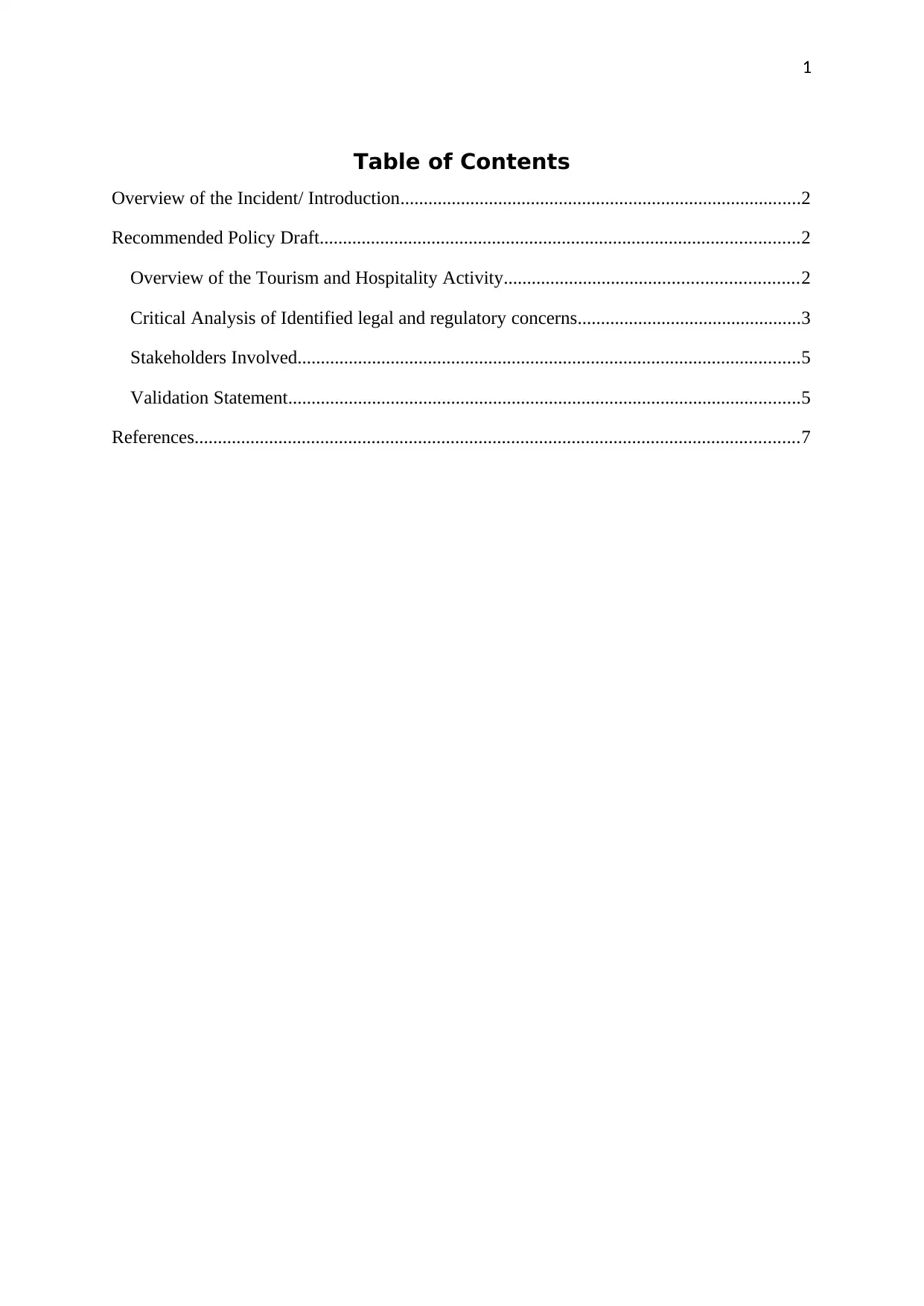
Table of Contents
Overview of the Incident/ Introduction......................................................................................2
Recommended Policy Draft.......................................................................................................2
Overview of the Tourism and Hospitality Activity...............................................................2
Critical Analysis of Identified legal and regulatory concerns................................................3
Stakeholders Involved............................................................................................................5
Validation Statement..............................................................................................................5
References..................................................................................................................................7
1
Overview of the Incident/ Introduction......................................................................................2
Recommended Policy Draft.......................................................................................................2
Overview of the Tourism and Hospitality Activity...............................................................2
Critical Analysis of Identified legal and regulatory concerns................................................3
Stakeholders Involved............................................................................................................5
Validation Statement..............................................................................................................5
References..................................................................................................................................7
1
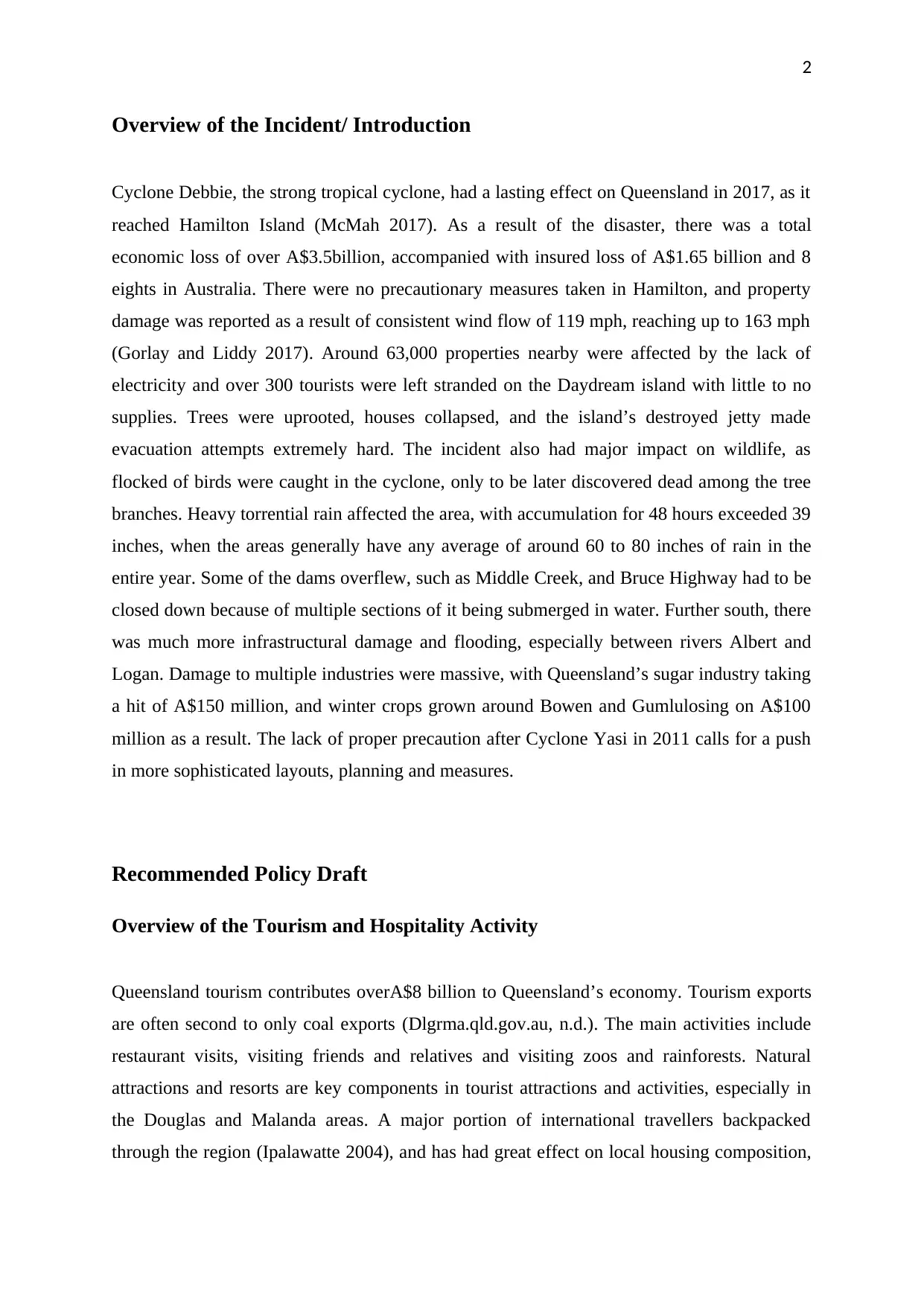
Overview of the Incident/ Introduction
Cyclone Debbie, the strong tropical cyclone, had a lasting effect on Queensland in 2017, as it
reached Hamilton Island (McMah 2017). As a result of the disaster, there was a total
economic loss of over A$3.5billion, accompanied with insured loss of A$1.65 billion and 8
eights in Australia. There were no precautionary measures taken in Hamilton, and property
damage was reported as a result of consistent wind flow of 119 mph, reaching up to 163 mph
(Gorlay and Liddy 2017). Around 63,000 properties nearby were affected by the lack of
electricity and over 300 tourists were left stranded on the Daydream island with little to no
supplies. Trees were uprooted, houses collapsed, and the island’s destroyed jetty made
evacuation attempts extremely hard. The incident also had major impact on wildlife, as
flocked of birds were caught in the cyclone, only to be later discovered dead among the tree
branches. Heavy torrential rain affected the area, with accumulation for 48 hours exceeded 39
inches, when the areas generally have any average of around 60 to 80 inches of rain in the
entire year. Some of the dams overflew, such as Middle Creek, and Bruce Highway had to be
closed down because of multiple sections of it being submerged in water. Further south, there
was much more infrastructural damage and flooding, especially between rivers Albert and
Logan. Damage to multiple industries were massive, with Queensland’s sugar industry taking
a hit of A$150 million, and winter crops grown around Bowen and Gumlulosing on A$100
million as a result. The lack of proper precaution after Cyclone Yasi in 2011 calls for a push
in more sophisticated layouts, planning and measures.
Recommended Policy Draft
Overview of the Tourism and Hospitality Activity
Queensland tourism contributes overA$8 billion to Queensland’s economy. Tourism exports
are often second to only coal exports (Dlgrma.qld.gov.au, n.d.). The main activities include
restaurant visits, visiting friends and relatives and visiting zoos and rainforests. Natural
attractions and resorts are key components in tourist attractions and activities, especially in
the Douglas and Malanda areas. A major portion of international travellers backpacked
through the region (Ipalawatte 2004), and has had great effect on local housing composition,
2
Cyclone Debbie, the strong tropical cyclone, had a lasting effect on Queensland in 2017, as it
reached Hamilton Island (McMah 2017). As a result of the disaster, there was a total
economic loss of over A$3.5billion, accompanied with insured loss of A$1.65 billion and 8
eights in Australia. There were no precautionary measures taken in Hamilton, and property
damage was reported as a result of consistent wind flow of 119 mph, reaching up to 163 mph
(Gorlay and Liddy 2017). Around 63,000 properties nearby were affected by the lack of
electricity and over 300 tourists were left stranded on the Daydream island with little to no
supplies. Trees were uprooted, houses collapsed, and the island’s destroyed jetty made
evacuation attempts extremely hard. The incident also had major impact on wildlife, as
flocked of birds were caught in the cyclone, only to be later discovered dead among the tree
branches. Heavy torrential rain affected the area, with accumulation for 48 hours exceeded 39
inches, when the areas generally have any average of around 60 to 80 inches of rain in the
entire year. Some of the dams overflew, such as Middle Creek, and Bruce Highway had to be
closed down because of multiple sections of it being submerged in water. Further south, there
was much more infrastructural damage and flooding, especially between rivers Albert and
Logan. Damage to multiple industries were massive, with Queensland’s sugar industry taking
a hit of A$150 million, and winter crops grown around Bowen and Gumlulosing on A$100
million as a result. The lack of proper precaution after Cyclone Yasi in 2011 calls for a push
in more sophisticated layouts, planning and measures.
Recommended Policy Draft
Overview of the Tourism and Hospitality Activity
Queensland tourism contributes overA$8 billion to Queensland’s economy. Tourism exports
are often second to only coal exports (Dlgrma.qld.gov.au, n.d.). The main activities include
restaurant visits, visiting friends and relatives and visiting zoos and rainforests. Natural
attractions and resorts are key components in tourist attractions and activities, especially in
the Douglas and Malanda areas. A major portion of international travellers backpacked
through the region (Ipalawatte 2004), and has had great effect on local housing composition,
2
⊘ This is a preview!⊘
Do you want full access?
Subscribe today to unlock all pages.

Trusted by 1+ million students worldwide
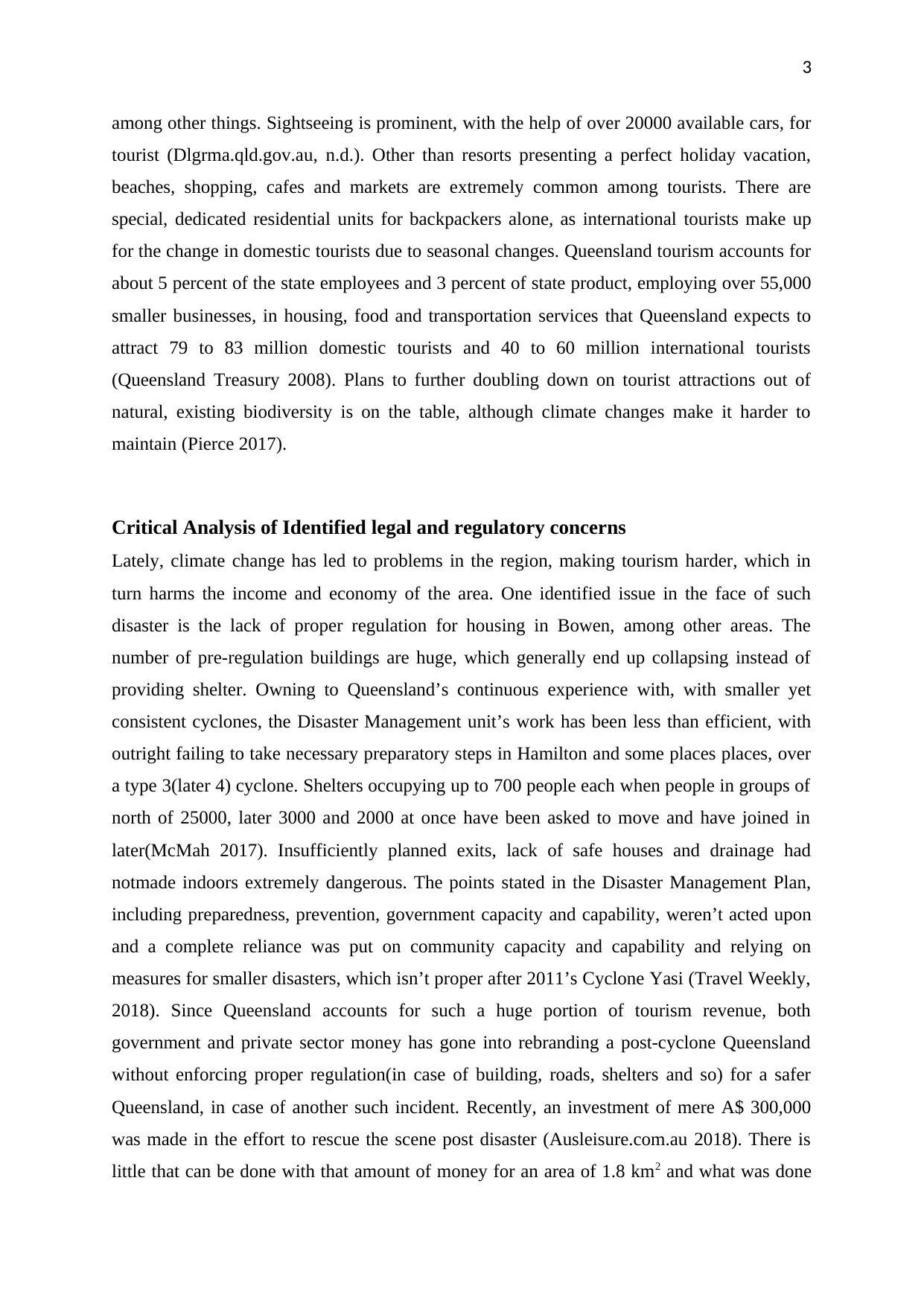
among other things. Sightseeing is prominent, with the help of over 20000 available cars, for
tourist (Dlgrma.qld.gov.au, n.d.). Other than resorts presenting a perfect holiday vacation,
beaches, shopping, cafes and markets are extremely common among tourists. There are
special, dedicated residential units for backpackers alone, as international tourists make up
for the change in domestic tourists due to seasonal changes. Queensland tourism accounts for
about 5 percent of the state employees and 3 percent of state product, employing over 55,000
smaller businesses, in housing, food and transportation services that Queensland expects to
attract 79 to 83 million domestic tourists and 40 to 60 million international tourists
(Queensland Treasury 2008). Plans to further doubling down on tourist attractions out of
natural, existing biodiversity is on the table, although climate changes make it harder to
maintain (Pierce 2017).
Critical Analysis of Identified legal and regulatory concerns
Lately, climate change has led to problems in the region, making tourism harder, which in
turn harms the income and economy of the area. One identified issue in the face of such
disaster is the lack of proper regulation for housing in Bowen, among other areas. The
number of pre-regulation buildings are huge, which generally end up collapsing instead of
providing shelter. Owning to Queensland’s continuous experience with, with smaller yet
consistent cyclones, the Disaster Management unit’s work has been less than efficient, with
outright failing to take necessary preparatory steps in Hamilton and some places places, over
a type 3(later 4) cyclone. Shelters occupying up to 700 people each when people in groups of
north of 25000, later 3000 and 2000 at once have been asked to move and have joined in
later(McMah 2017). Insufficiently planned exits, lack of safe houses and drainage had
notmade indoors extremely dangerous. The points stated in the Disaster Management Plan,
including preparedness, prevention, government capacity and capability, weren’t acted upon
and a complete reliance was put on community capacity and capability and relying on
measures for smaller disasters, which isn’t proper after 2011’s Cyclone Yasi (Travel Weekly,
2018). Since Queensland accounts for such a huge portion of tourism revenue, both
government and private sector money has gone into rebranding a post-cyclone Queensland
without enforcing proper regulation(in case of building, roads, shelters and so) for a safer
Queensland, in case of another such incident. Recently, an investment of mere A$ 300,000
was made in the effort to rescue the scene post disaster (Ausleisure.com.au 2018). There is
little that can be done with that amount of money for an area of 1.8 km2 and what was done
3
tourist (Dlgrma.qld.gov.au, n.d.). Other than resorts presenting a perfect holiday vacation,
beaches, shopping, cafes and markets are extremely common among tourists. There are
special, dedicated residential units for backpackers alone, as international tourists make up
for the change in domestic tourists due to seasonal changes. Queensland tourism accounts for
about 5 percent of the state employees and 3 percent of state product, employing over 55,000
smaller businesses, in housing, food and transportation services that Queensland expects to
attract 79 to 83 million domestic tourists and 40 to 60 million international tourists
(Queensland Treasury 2008). Plans to further doubling down on tourist attractions out of
natural, existing biodiversity is on the table, although climate changes make it harder to
maintain (Pierce 2017).
Critical Analysis of Identified legal and regulatory concerns
Lately, climate change has led to problems in the region, making tourism harder, which in
turn harms the income and economy of the area. One identified issue in the face of such
disaster is the lack of proper regulation for housing in Bowen, among other areas. The
number of pre-regulation buildings are huge, which generally end up collapsing instead of
providing shelter. Owning to Queensland’s continuous experience with, with smaller yet
consistent cyclones, the Disaster Management unit’s work has been less than efficient, with
outright failing to take necessary preparatory steps in Hamilton and some places places, over
a type 3(later 4) cyclone. Shelters occupying up to 700 people each when people in groups of
north of 25000, later 3000 and 2000 at once have been asked to move and have joined in
later(McMah 2017). Insufficiently planned exits, lack of safe houses and drainage had
notmade indoors extremely dangerous. The points stated in the Disaster Management Plan,
including preparedness, prevention, government capacity and capability, weren’t acted upon
and a complete reliance was put on community capacity and capability and relying on
measures for smaller disasters, which isn’t proper after 2011’s Cyclone Yasi (Travel Weekly,
2018). Since Queensland accounts for such a huge portion of tourism revenue, both
government and private sector money has gone into rebranding a post-cyclone Queensland
without enforcing proper regulation(in case of building, roads, shelters and so) for a safer
Queensland, in case of another such incident. Recently, an investment of mere A$ 300,000
was made in the effort to rescue the scene post disaster (Ausleisure.com.au 2018). There is
little that can be done with that amount of money for an area of 1.8 km2 and what was done
3
Paraphrase This Document
Need a fresh take? Get an instant paraphrase of this document with our AI Paraphraser
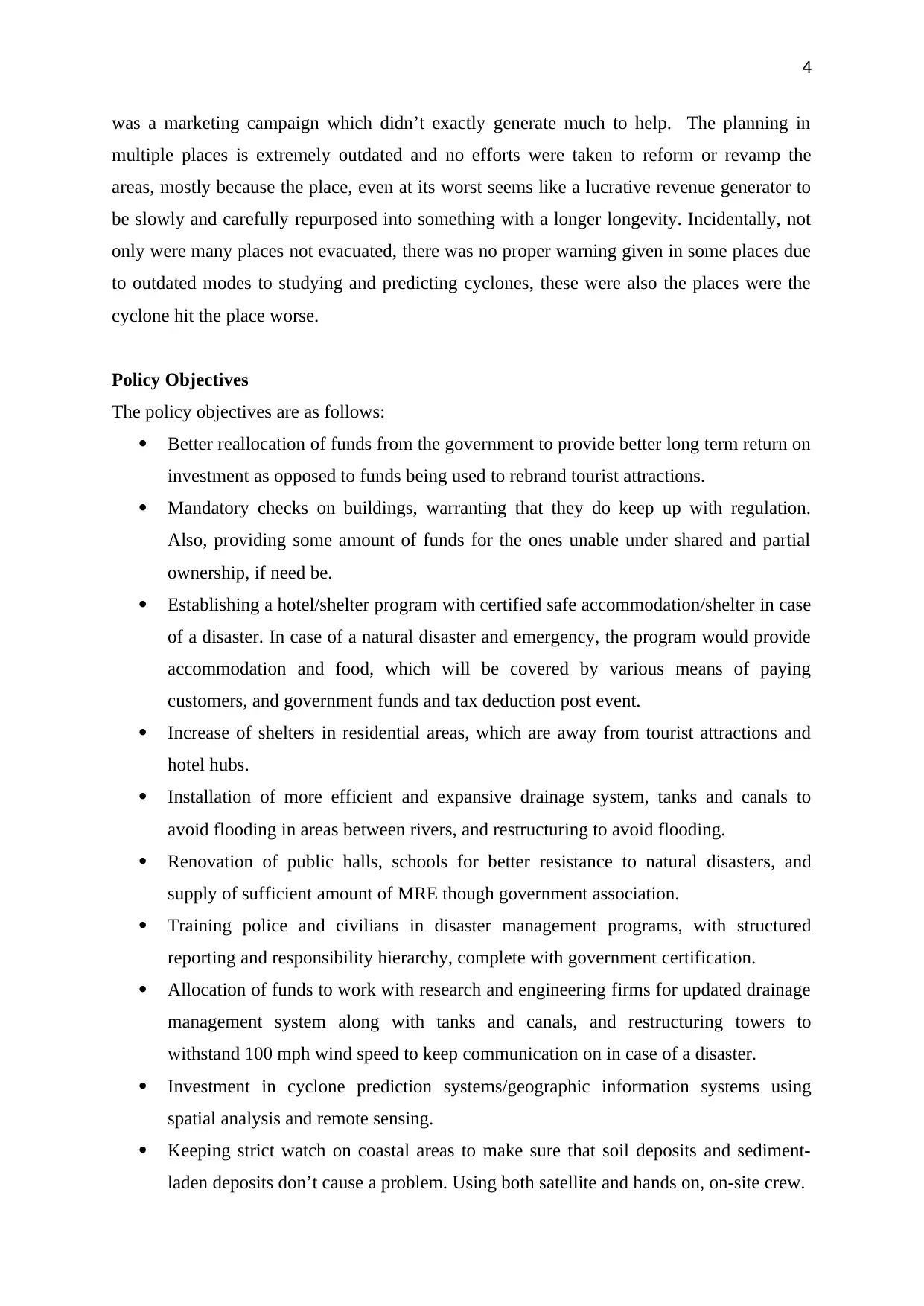
was a marketing campaign which didn’t exactly generate much to help. The planning in
multiple places is extremely outdated and no efforts were taken to reform or revamp the
areas, mostly because the place, even at its worst seems like a lucrative revenue generator to
be slowly and carefully repurposed into something with a longer longevity. Incidentally, not
only were many places not evacuated, there was no proper warning given in some places due
to outdated modes to studying and predicting cyclones, these were also the places were the
cyclone hit the place worse.
Policy Objectives
The policy objectives are as follows:
Better reallocation of funds from the government to provide better long term return on
investment as opposed to funds being used to rebrand tourist attractions.
Mandatory checks on buildings, warranting that they do keep up with regulation.
Also, providing some amount of funds for the ones unable under shared and partial
ownership, if need be.
Establishing a hotel/shelter program with certified safe accommodation/shelter in case
of a disaster. In case of a natural disaster and emergency, the program would provide
accommodation and food, which will be covered by various means of paying
customers, and government funds and tax deduction post event.
Increase of shelters in residential areas, which are away from tourist attractions and
hotel hubs.
Installation of more efficient and expansive drainage system, tanks and canals to
avoid flooding in areas between rivers, and restructuring to avoid flooding.
Renovation of public halls, schools for better resistance to natural disasters, and
supply of sufficient amount of MRE though government association.
Training police and civilians in disaster management programs, with structured
reporting and responsibility hierarchy, complete with government certification.
Allocation of funds to work with research and engineering firms for updated drainage
management system along with tanks and canals, and restructuring towers to
withstand 100 mph wind speed to keep communication on in case of a disaster.
Investment in cyclone prediction systems/geographic information systems using
spatial analysis and remote sensing.
Keeping strict watch on coastal areas to make sure that soil deposits and sediment-
laden deposits don’t cause a problem. Using both satellite and hands on, on-site crew.
4
multiple places is extremely outdated and no efforts were taken to reform or revamp the
areas, mostly because the place, even at its worst seems like a lucrative revenue generator to
be slowly and carefully repurposed into something with a longer longevity. Incidentally, not
only were many places not evacuated, there was no proper warning given in some places due
to outdated modes to studying and predicting cyclones, these were also the places were the
cyclone hit the place worse.
Policy Objectives
The policy objectives are as follows:
Better reallocation of funds from the government to provide better long term return on
investment as opposed to funds being used to rebrand tourist attractions.
Mandatory checks on buildings, warranting that they do keep up with regulation.
Also, providing some amount of funds for the ones unable under shared and partial
ownership, if need be.
Establishing a hotel/shelter program with certified safe accommodation/shelter in case
of a disaster. In case of a natural disaster and emergency, the program would provide
accommodation and food, which will be covered by various means of paying
customers, and government funds and tax deduction post event.
Increase of shelters in residential areas, which are away from tourist attractions and
hotel hubs.
Installation of more efficient and expansive drainage system, tanks and canals to
avoid flooding in areas between rivers, and restructuring to avoid flooding.
Renovation of public halls, schools for better resistance to natural disasters, and
supply of sufficient amount of MRE though government association.
Training police and civilians in disaster management programs, with structured
reporting and responsibility hierarchy, complete with government certification.
Allocation of funds to work with research and engineering firms for updated drainage
management system along with tanks and canals, and restructuring towers to
withstand 100 mph wind speed to keep communication on in case of a disaster.
Investment in cyclone prediction systems/geographic information systems using
spatial analysis and remote sensing.
Keeping strict watch on coastal areas to make sure that soil deposits and sediment-
laden deposits don’t cause a problem. Using both satellite and hands on, on-site crew.
4
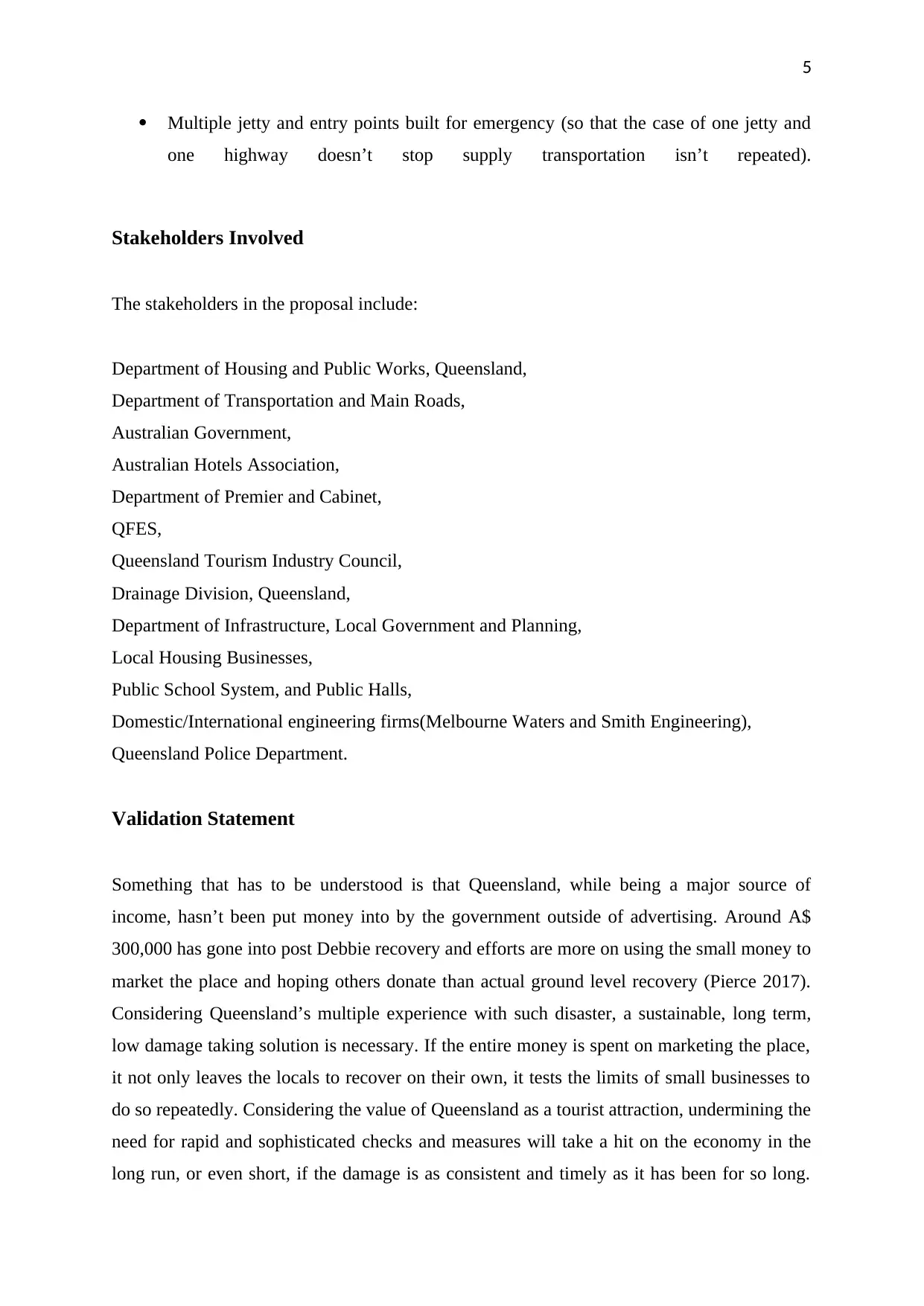
Multiple jetty and entry points built for emergency (so that the case of one jetty and
one highway doesn’t stop supply transportation isn’t repeated).
Stakeholders Involved
The stakeholders in the proposal include:
Department of Housing and Public Works, Queensland,
Department of Transportation and Main Roads,
Australian Government,
Australian Hotels Association,
Department of Premier and Cabinet,
QFES,
Queensland Tourism Industry Council,
Drainage Division, Queensland,
Department of Infrastructure, Local Government and Planning,
Local Housing Businesses,
Public School System, and Public Halls,
Domestic/International engineering firms(Melbourne Waters and Smith Engineering),
Queensland Police Department.
Validation Statement
Something that has to be understood is that Queensland, while being a major source of
income, hasn’t been put money into by the government outside of advertising. Around A$
300,000 has gone into post Debbie recovery and efforts are more on using the small money to
market the place and hoping others donate than actual ground level recovery (Pierce 2017).
Considering Queensland’s multiple experience with such disaster, a sustainable, long term,
low damage taking solution is necessary. If the entire money is spent on marketing the place,
it not only leaves the locals to recover on their own, it tests the limits of small businesses to
do so repeatedly. Considering the value of Queensland as a tourist attraction, undermining the
need for rapid and sophisticated checks and measures will take a hit on the economy in the
long run, or even short, if the damage is as consistent and timely as it has been for so long.
5
one highway doesn’t stop supply transportation isn’t repeated).
Stakeholders Involved
The stakeholders in the proposal include:
Department of Housing and Public Works, Queensland,
Department of Transportation and Main Roads,
Australian Government,
Australian Hotels Association,
Department of Premier and Cabinet,
QFES,
Queensland Tourism Industry Council,
Drainage Division, Queensland,
Department of Infrastructure, Local Government and Planning,
Local Housing Businesses,
Public School System, and Public Halls,
Domestic/International engineering firms(Melbourne Waters and Smith Engineering),
Queensland Police Department.
Validation Statement
Something that has to be understood is that Queensland, while being a major source of
income, hasn’t been put money into by the government outside of advertising. Around A$
300,000 has gone into post Debbie recovery and efforts are more on using the small money to
market the place and hoping others donate than actual ground level recovery (Pierce 2017).
Considering Queensland’s multiple experience with such disaster, a sustainable, long term,
low damage taking solution is necessary. If the entire money is spent on marketing the place,
it not only leaves the locals to recover on their own, it tests the limits of small businesses to
do so repeatedly. Considering the value of Queensland as a tourist attraction, undermining the
need for rapid and sophisticated checks and measures will take a hit on the economy in the
long run, or even short, if the damage is as consistent and timely as it has been for so long.
5
⊘ This is a preview!⊘
Do you want full access?
Subscribe today to unlock all pages.

Trusted by 1+ million students worldwide
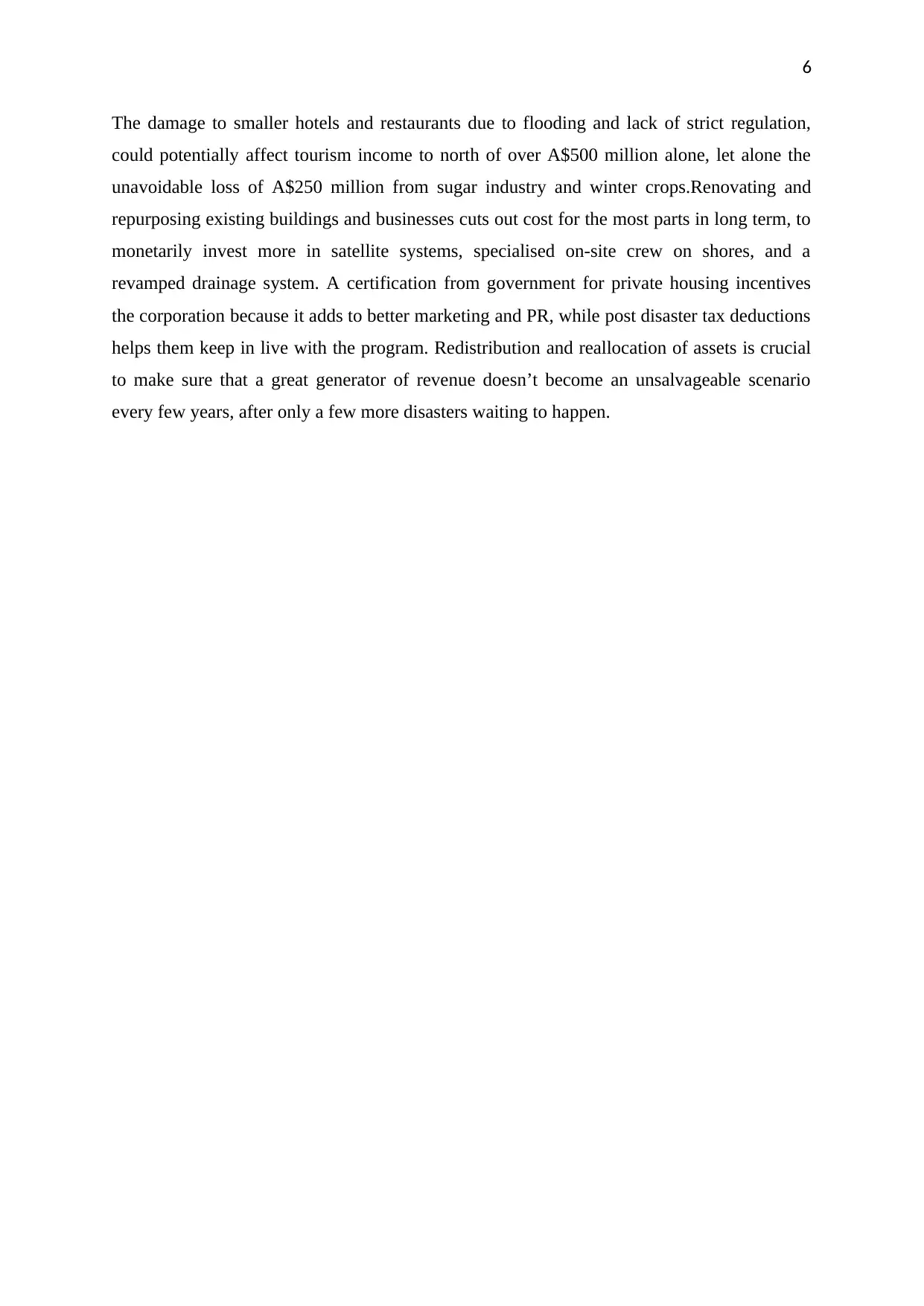
The damage to smaller hotels and restaurants due to flooding and lack of strict regulation,
could potentially affect tourism income to north of over A$500 million alone, let alone the
unavoidable loss of A$250 million from sugar industry and winter crops.Renovating and
repurposing existing buildings and businesses cuts out cost for the most parts in long term, to
monetarily invest more in satellite systems, specialised on-site crew on shores, and a
revamped drainage system. A certification from government for private housing incentives
the corporation because it adds to better marketing and PR, while post disaster tax deductions
helps them keep in live with the program. Redistribution and reallocation of assets is crucial
to make sure that a great generator of revenue doesn’t become an unsalvageable scenario
every few years, after only a few more disasters waiting to happen.
6
could potentially affect tourism income to north of over A$500 million alone, let alone the
unavoidable loss of A$250 million from sugar industry and winter crops.Renovating and
repurposing existing buildings and businesses cuts out cost for the most parts in long term, to
monetarily invest more in satellite systems, specialised on-site crew on shores, and a
revamped drainage system. A certification from government for private housing incentives
the corporation because it adds to better marketing and PR, while post disaster tax deductions
helps them keep in live with the program. Redistribution and reallocation of assets is crucial
to make sure that a great generator of revenue doesn’t become an unsalvageable scenario
every few years, after only a few more disasters waiting to happen.
6
Paraphrase This Document
Need a fresh take? Get an instant paraphrase of this document with our AI Paraphraser
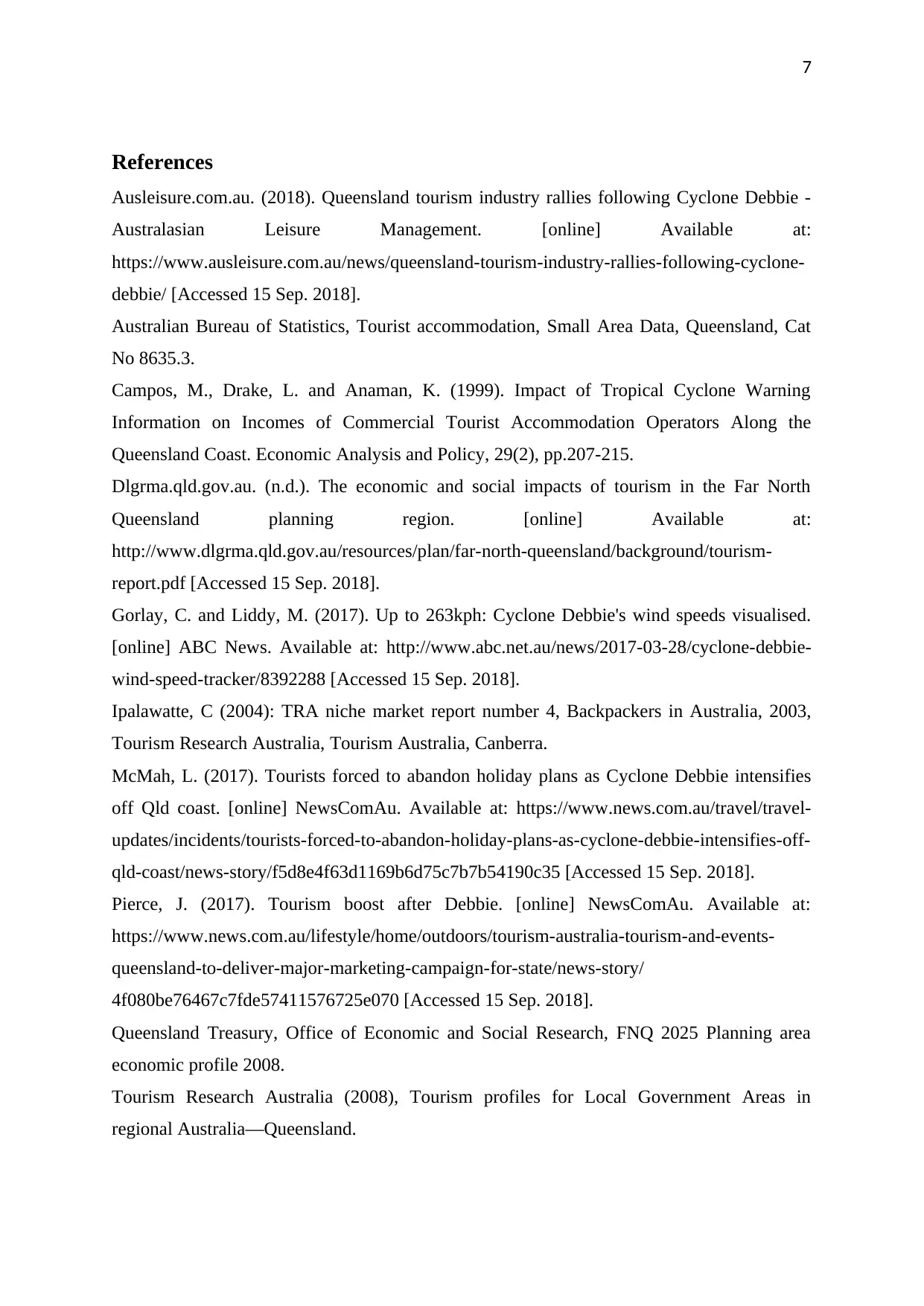
References
Ausleisure.com.au. (2018). Queensland tourism industry rallies following Cyclone Debbie -
Australasian Leisure Management. [online] Available at:
https://www.ausleisure.com.au/news/queensland-tourism-industry-rallies-following-cyclone-
debbie/ [Accessed 15 Sep. 2018].
Australian Bureau of Statistics, Tourist accommodation, Small Area Data, Queensland, Cat
No 8635.3.
Campos, M., Drake, L. and Anaman, K. (1999). Impact of Tropical Cyclone Warning
Information on Incomes of Commercial Tourist Accommodation Operators Along the
Queensland Coast. Economic Analysis and Policy, 29(2), pp.207-215.
Dlgrma.qld.gov.au. (n.d.). The economic and social impacts of tourism in the Far North
Queensland planning region. [online] Available at:
http://www.dlgrma.qld.gov.au/resources/plan/far-north-queensland/background/tourism-
report.pdf [Accessed 15 Sep. 2018].
Gorlay, C. and Liddy, M. (2017). Up to 263kph: Cyclone Debbie's wind speeds visualised.
[online] ABC News. Available at: http://www.abc.net.au/news/2017-03-28/cyclone-debbie-
wind-speed-tracker/8392288 [Accessed 15 Sep. 2018].
Ipalawatte, C (2004): TRA niche market report number 4, Backpackers in Australia, 2003,
Tourism Research Australia, Tourism Australia, Canberra.
McMah, L. (2017). Tourists forced to abandon holiday plans as Cyclone Debbie intensifies
off Qld coast. [online] NewsComAu. Available at: https://www.news.com.au/travel/travel-
updates/incidents/tourists-forced-to-abandon-holiday-plans-as-cyclone-debbie-intensifies-off-
qld-coast/news-story/f5d8e4f63d1169b6d75c7b7b54190c35 [Accessed 15 Sep. 2018].
Pierce, J. (2017). Tourism boost after Debbie. [online] NewsComAu. Available at:
https://www.news.com.au/lifestyle/home/outdoors/tourism-australia-tourism-and-events-
queensland-to-deliver-major-marketing-campaign-for-state/news-story/
4f080be76467c7fde57411576725e070 [Accessed 15 Sep. 2018].
Queensland Treasury, Office of Economic and Social Research, FNQ 2025 Planning area
economic profile 2008.
Tourism Research Australia (2008), Tourism profiles for Local Government Areas in
regional Australia—Queensland.
7
Ausleisure.com.au. (2018). Queensland tourism industry rallies following Cyclone Debbie -
Australasian Leisure Management. [online] Available at:
https://www.ausleisure.com.au/news/queensland-tourism-industry-rallies-following-cyclone-
debbie/ [Accessed 15 Sep. 2018].
Australian Bureau of Statistics, Tourist accommodation, Small Area Data, Queensland, Cat
No 8635.3.
Campos, M., Drake, L. and Anaman, K. (1999). Impact of Tropical Cyclone Warning
Information on Incomes of Commercial Tourist Accommodation Operators Along the
Queensland Coast. Economic Analysis and Policy, 29(2), pp.207-215.
Dlgrma.qld.gov.au. (n.d.). The economic and social impacts of tourism in the Far North
Queensland planning region. [online] Available at:
http://www.dlgrma.qld.gov.au/resources/plan/far-north-queensland/background/tourism-
report.pdf [Accessed 15 Sep. 2018].
Gorlay, C. and Liddy, M. (2017). Up to 263kph: Cyclone Debbie's wind speeds visualised.
[online] ABC News. Available at: http://www.abc.net.au/news/2017-03-28/cyclone-debbie-
wind-speed-tracker/8392288 [Accessed 15 Sep. 2018].
Ipalawatte, C (2004): TRA niche market report number 4, Backpackers in Australia, 2003,
Tourism Research Australia, Tourism Australia, Canberra.
McMah, L. (2017). Tourists forced to abandon holiday plans as Cyclone Debbie intensifies
off Qld coast. [online] NewsComAu. Available at: https://www.news.com.au/travel/travel-
updates/incidents/tourists-forced-to-abandon-holiday-plans-as-cyclone-debbie-intensifies-off-
qld-coast/news-story/f5d8e4f63d1169b6d75c7b7b54190c35 [Accessed 15 Sep. 2018].
Pierce, J. (2017). Tourism boost after Debbie. [online] NewsComAu. Available at:
https://www.news.com.au/lifestyle/home/outdoors/tourism-australia-tourism-and-events-
queensland-to-deliver-major-marketing-campaign-for-state/news-story/
4f080be76467c7fde57411576725e070 [Accessed 15 Sep. 2018].
Queensland Treasury, Office of Economic and Social Research, FNQ 2025 Planning area
economic profile 2008.
Tourism Research Australia (2008), Tourism profiles for Local Government Areas in
regional Australia—Queensland.
7

Travel Weekly. (2017). Cyclone Debbie's impact on tourism - Travel Weekly. [online]
Available at: http://www.travelweekly.com.au/article/cyclone-debbies-impact-on-tourism/
[Accessed 15 Sep. 2018].
8
Available at: http://www.travelweekly.com.au/article/cyclone-debbies-impact-on-tourism/
[Accessed 15 Sep. 2018].
8
⊘ This is a preview!⊘
Do you want full access?
Subscribe today to unlock all pages.

Trusted by 1+ million students worldwide
1 out of 9
Your All-in-One AI-Powered Toolkit for Academic Success.
+13062052269
info@desklib.com
Available 24*7 on WhatsApp / Email
![[object Object]](/_next/static/media/star-bottom.7253800d.svg)
Unlock your academic potential
Copyright © 2020–2025 A2Z Services. All Rights Reserved. Developed and managed by ZUCOL.